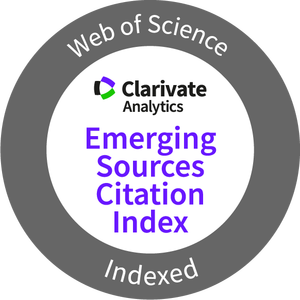Game-like situations training method and endurance impact on volleyball player performance
Abstract
This study aimed to examine the impact of game-like situations training on the improvement of cardiovascular fitness and volleyball skills among high school students. The quasi-experimental design involved a sample of 32 secondary school students aged 13-17 years, divided into four groups based on two training methods (game-like situations and endurance) and two skill levels (high and low). The 8-week program, with sessions twice a week, focused on improving players' technical skills such as passing, setting, and ball control, as well as their cardiovascular endurance. Data were collected through the Yo-Yo Intermittent Recovery Test to measure cardiovascular fitness, alongside physical endurance tests. The results showed that the game-like situations training method was more effective than endurance training in improving volleyball skills, particularly for players with high skill levels. While endurance also played a significant role, combining game-like situations with endurance training yielded dual benefits, enhancing both technical skills and cardiovascular fitness. This study suggests that integrating game-like situations into volleyball training programs at the adolescent level is essential for the holistic development of players. Further research is recommended to explore additional factors influencing skill development and to assess the long-term impact of these training methods.
Downloads
-
Abstract395
-
PDF332
References
Akhmad, I., Suharjo, Hariadi, Dewi, R., & Supriadi, A. (2022). The effects of learning strategies on senior high school students’ motivation and learning outcomes of overhead passing in volleyball. International Journal of Education in Mathematics, Science and Technology, 10(2), 458–476. https://doi.org/10.46328/ijemst.2291
AlSamhori, J. F., Alshrouf, M. A., AlSamhori, A. R. F., Alshadeedi, F. M., Madi, A. S., & Alzoubi, O. (2023). Implications of the COVID-19 pandemic on athletes, sports events, and mass gathering events: Review and recommendations. Sports Medicine and Health Science, 5(3), 165–173. https://doi.org/10.1016/j.smhs.2023.07.006
Ashford, M., Abraham, A., & Poolton, J. (2021). Understanding a player’s decision-making process in team sports: A systematic review of empirical evidence. Sports, 9(5), 1-29. https://doi.org/10.3390/sports9050065
Bakhtiar, S., Harris Sujae, I., Kudo, S., Rizal Wan Zakaria, W., Ong, A., & Hamill, J. (2020). Developing a system to determine impact force in tennis. Journal of Physics: Conference Series, 1528(1), 1-4. https://doi.org/10.1088/1742-6596/1528/1/012054
Bakhtiar, S., Syahputra, R., Putri, L. P., Mardiansyah, A., Atradinal, Hendrayana, A. A., Afrian, H., Mardela, R., & Pion, J. (2023). Sports talent profile of 7–12 years old: Preliminary study of talent identification in Indonesia. Journal of Physical Education and Sport, 23(12), 3167–3177. https://doi.org/10.7752/jpes.2023.12361
Crespo, M., Reid, M. M., & Miley, D. (2004). Tennis: Applied examples of a game-based teaching approach. Strategies, 17(4), 27–30. https://doi.org/10.1080/08924562.2004.10591100
Harvey, S., Gil-Arias, A., & Claver, F. (2020). Effects of teaching games for understanding on tactical knowledge development in middle school physical education. Journal of Physical Education and Sport, 20(3), 1369–1379. https://doi.org/10.7752/jpes.2020.03189
Latino, F., Martinez-Roig, R., Susanto, N., Setyawan, H., Anam, K., Saraiello, E., Tafuri, D., & Tafuri, F. (2024). Endurance training and physiological variables: Effects on sub-elite volleyball players. Retos, 58, 522–527. https://doi.org/10.47197/retos.v58.107636
Luo, S., Soh, K. G., Zhang, L., Zhai, X., Sunardi, J., Gao, Y., & Sun, H. (2023). Effect of core training on skill-related physical fitness performance among soccer players: A systematic review. Frontiers in Public Health, 10, 1-14. https://doi.org/10.3389/fpubh.2022.1046456
Mardius, A., Sofyan, D., Hadi, R. S., Barlian, E., Ihsan, N., Astuti, Y., & Ockta, Y. (2025). Effectiveness of interval training in increasing VO2max in pencak silat athletes. Sport TK, 14, 1–13. https://doi.org/10.6018/sportk.643791
Milovancev, A., Avakumovic, J., Lakicevic, N., Stajer, V., Korovljev, D., Todorovic, N., Bianco, A., Maksimovic, N., Ostojic, S., & Drid, P. (2021). Cardiorespiratory fitness in volleyball athletes following a COVID-19 infection: A cross-sectional study. International Journal of Environmental Research and Public Health, 18(8), 1-8. https://doi.org/10.3390/ijerph18084059
Mocanu, G. D., Harabagiu, N., & Pârvu, C. (2024). Attack efficiency in first league men’s volleyball for playing positions, according to the value level of the teams. Pedagogy of Physical Culture and Sports, 28(5), 424–439. https://doi.org/10.15561/26649837.2024.0511
Oliinyk, I., Doroshenko, E., Melnyk, M., Sushko, R., Tyshchenko, V., & Shamardin, V. (2021). Modern approaches to analysis of technical and tactical actions of skilled volleyball players. Physical Education Theory and Methodology, 21(3), 235–243. https://doi.org/10.17309/TMFV.2021.3.07
Raab, M. (2007). Think SMART, not hard – A review of teaching decision making in sport from an ecological rationality perspective. Physical Education & Sport Pedagogy, 12(1), 1–22.
Risma, N., Bakhtiar, S., Umar, I., Ilham, F., Zarya, F., Ndayisenga, J., & Zakaria, J. B. (2024). The effects of various teaching approaches in physical education students on the performance of volleyball skills: A systematic review. Fizjoterapia Polska, 24(1), 331–336. https://doi.org/10.56984/8ZG2EF8cY4
Ronkainen, N. J., Aggerholm, K., Ryba, T. V., & Allen-Collinson, J. (2021). Learning in sport: From life skills to existential learning. Sport, Education and Society, 26(2), 214–227. https://doi.org/10.1080/13573322.2020.1712655
Schuch, F. B., & Vancampfort, D. (2021). Physical activity, exercise, and mental disorders: It is time to move on. Trends in Psychiatry and Psychotherapy, 43(3), 177–184. https://doi.org/10.47626/2237-6089-2021-0237
Sgrò, F., Barca, M., Mollame, F., Orofino, F., Quinto, A., & Stodden, D. (2024). The impact of sport-specific practice on health-related physical fitness components in young water polo and volleyball athletes. Applied Sciences, 14(20), 1-10. https://doi.org/10.3390/app14209316
Umar, Ockta, Y., & Mardesia, P. (2023). A correlational study: Pedagogical and professional competence of physical education teachers in relation to the implementation of the Merdeka curriculum. Journal of Physical Education and Sport, 23(12), 3325–3331. https://doi.org/10.7752/jpes.2023.12380
The works and papers that are published in this Journal are subject to the following terms:
1. The Publication Service of the University of Murcia (the publisher) has the Publication Rights (Copyright) to the published papers and works, and favors and permits the reusing of the same under the license indicated in point 2.
© Servicio de Publicaciones, Universidad de Murcia, 2013
2. The papers and works are to be published in the digital edition of the Journal under the license Creative Commons Reconocimiento-No Comercial-Sin Obra Derivada 3.0 España (legal text). The copying, using, spreading, transmitting and publicly displaying of the papers, works or publication are permitted as long as: i) the authors and original sources (Journal, publisher and URL of the publication) are quoted; ii) it is not used for commercial benefit; iii) the existence and specifications of this users license are mentioned.
3. Conditions of Self-Archiving. It is permitted and encouraged that the authors spread electronically the pre-print (before printing) and/or post-print (the revised, evaluated and accepted) versions of their papers or works before their publication since this favors their circulation and early diffusion and therefore can help increase their citation and quotation, and also there reach through the academic community.
The works and papers that are published in this Journal are subject to the following terms:
1. The Publication Service of the University of Murcia (the publisher) has the Publication Rights (Copyright) to the published papers and works, and favors and permits the reusing of the same under the license indicated in point 2.
© Servicio de Publicaciones, Universidad de Murcia, 2013
2. The papers and works are to be published in the digital edition of the Journal under the license Creative Commons Reconocimiento-No Comercial-Sin Obra Derivada 3.0 España (legal text). The copying, using, spreading, transmitting and publicly displaying of the papers, works or publication are permitted as long as: i) the authors and original sources (Journal, publisher and URL of the publication) are quoted; ii) it is not used for commercial benefit; iii) the existence and specifications of this users license are mentioned.
3. Conditions of Self-Archiving. It is permitted and encouraged that the authors spread electronically the pre-print (before printing) and/or post-print (the revised, evaluated and accepted) versions of their papers or works before their publication since this favors their circulation and early diffusion and therefore can help increase their citation and quotation, and also there reach through the academic community.

















